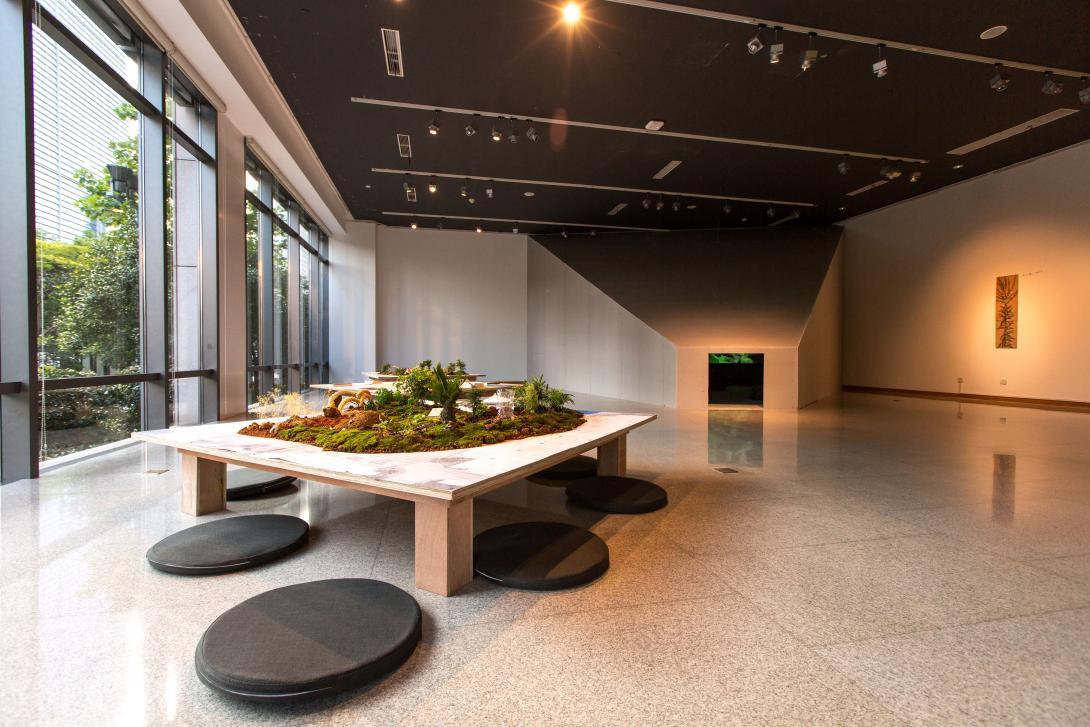NYU Shanghai’s art gallery re-opened October 10 with a new name, the Institute of Contemporary Arts (ICA) at NYU Shanghai, and a new exhibition, “Goldenrod,” featuring works by Hong Kong-based artist and educator Zheng Bo. The three-part exhibition – including several works co-created by Zheng and a group of NYU Shanghai community members, philosophers, ecologists, and other artists – highlights the new institute’s focus on collaborative research and experimentation in the arts.
ICA at NYU Shanghai Director and “Goldenrod” curator Michelle Yeonho Hyun said the ICA recasts NYU Shanghai’s gallery space as a true “institute,” a place for creation and critical engagement with the arts, rather than simply a place where art can be viewed.
“The ICA at NYU Shanghai approach to collaborating with artists is going to begin with two questions: ‘What are you working on now?’ and ‘What do you want to make next?’” said Hyun, who arrived on campus in August 2018 and spent the last year reconceptualizing and planning the new institute’s programming.
“Going forward, our focus is to give artists opportunities to experiment and generate new ideas.”
Faculty and students from NYU Shanghai join ecologists and landscape designers to create a design for a garden at the center of NYU Shanghai’s new campus plan. Photo courtesy of the artist and Edouard Malingue Gallery.
In light of this reinvigorated vision of the gallery as a collaborative space, reopening with an artist like Zheng is symbolic, Hyun said.
“The idea behind a lot of Zheng Bo’s work is to bring different audiences, actors, and collaborators together to generate art as co-equals,” said Hyun. “His practice has a very different relationship with knowledge that resonates with the purpose of university art galleries – and with the purpose of the ICA in particular – as research-oriented places of experimentation.”
Although Zheng’s work is primarily in visual art, Hyun says future plans for the ICA won’t be limited to two-dimensional, visual art. “The term ‘Arts’ in the ICA’s name is plural for a reason,” Hyun noted. “Our programming for the next few years will be much broader and inclusive of other forms of art and other artistic sensibilities.”
“Goldenrod” launches ICA at NYU Shanghai’s first two-year research program, “The (Invisible) Garden,” which will run from Fall 2019 through Spring 2021. The program will include three additional projects led by artists from around the globe, all exploring how gardens act as spaces for people to reimagine our relationship with nature by experimenting with new forms of coexistence.
Zheng’s charcoal drawing of the Canadian Goldenrod, one of the most ubiquitous weeds in Shanghai. On each of the 72 days of the exhibition, one viewer will write a reflection about the plant on the gallery wall. Photo by Hong Xiaole.
These are key issues Zheng Bo examines in his artistic practice with weeds, ferns, and other plants that often go unnoticed in human-oriented environments. Zheng’s work over the past nine years “investigates the past and imagines the future from the perspectives of marginalized communities and marginalized plants,” pushing audiences to re-examine their relationship with plants, as well as their ideas about them.
The trio of projects featured in ICA’s “Goldenrod” exhibition underscores this philosophy. The film series Pteridophilia, continuously broadcast inside a cave-like theater in the gallery’s center, investigates how queer bodies interact with queer plants. In the second part of the exhibit, a conceptual charcoal drawing on scrap wood of the Canadian Goldenrod re-focuses audiences’ attention on the ubiquitous but oft-overlooked weed, encouraging visitors to record their own reflections about the plant on the gallery walls. Finally, the “eco-socialist” garden design project – including living models of a garden that could form the center of NYU Shanghai’s new campus – co-created by Zheng and a group of intellectuals, students, and other artists rethinks gardens as places where humans and plants can connect as equals.
Visitors to the ICA view Pteridophilia inside the gallery’s specially built theater space designed by Zheng.
In an interview on the eve of the show’s opening, Zheng said that the ICA’s mission to educate through collaborative art not only gives him more room to grow as an artist, but also provides audiences with opportunities to think holistically about compelling social and environmental issues that span multiple disciplines.
“Even interdisciplinary programs have difficulty addressing questions that require not only thinking in terms of language, but also thinking in terms of visual experience and bodily experience,” said Zheng. “I think this is what art means today. It’s a space where we as humans can use all our faculties and capacities to wrestle with very important questions.”
Hyun agreed that the ICA’s mission complements both the university’s mission to foster interdisciplinary study and its commitment to creating global citizens who understand identity and belonging in multiple different layers.
“Contemporary art moves in between spaces for different disciplinary concentrations, in much the same way as our lives and identities move between different tracks,” Hyun said. “That’s what is so great about contemporary art: It’s capacious enough to allow people to create things that may not be received in the way we anticipate.”
“Goldenrod” runs through December 21st, 2019. Beginning October 11, the ICA gallery will open Tuesday through Saturday from 11 am to 6 pm. To learn more about the Institute of Contemporary Arts at NYU Shanghai, please visit ica.shanghai.nyu.edu


